The WiFi wireless router is perhaps THE central piece in most home computer networks these days. So we often hear talk of common router issues and how to solve them. Thus here, we explain how to fix WiFi router problems, with deep dives into some of these so often seen router issues.
So many of us now are setting up WiFi networks in our homes, dorms, classrooms, et al. It’s likely also, that most of us have seen some sort of WiFi router trouble. Most router problems show up as follows…
- A loss of internet on wireless devices.
- Either no or weak WiFi signal.
- Inability to log in to the WiFi.
- Sporadic, slow, or unreliable WiFi.
Take the easy to work steps below before trying to troubleshoot the router. These simple fixes could solve your problem without much detective work.
How to Fix WiFi Router: Easy Fixes
Check for Blocked Vents
Sitting the router on a carpeted floor for example, on its side, may obstruct ventilation. This can cause overheating and poor router performance.
Replace Any Broken or Kinked Ethernet Cables
Perhaps an RJ-45 plug on an Ethernet cable has broken latch tabs. Or you may have abrupt kinks and bends in the cables. So try replacing with a fresh, undamaged cable to see if that fixes your router problem.
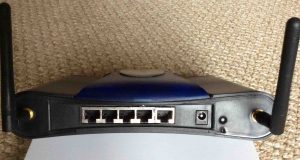
Check Correct Cable Connections
Make sure that the WAN cable, from modem to router connects to the WAN port on the router. Also, connect any DMZ (demilitarized zone) hosts you have to the correct local port on the router. Check the router guides to see which port acts as a DMZ port.
Reboot Cable / DSL Modem and Router
Doing this is easier when your WiFi router and ISP modem are one unit. Simply power off that unit. Wait thirty seconds. Then power it up again.
Detail
It’s best to do a “cold” reboot, where you actually disconnect the router from power. The “warm” reboots, those that you trigger on the router’s admin web site, may not fully reset the hardware.
Install Latest Router Firmware Update
Older firmware may have bugs that show up under more load. These often appear when you add more data demanding devices to your network. A firmware update may increase stable router capacity and make multi-user connections work better.
Reset Router to Factory Default State
Now someone may have changed a crucial setting to a bad value. E.g. WiFi beacon interval, DTS, RTS, et al, The wrong values in these settings can slow down wireless data speeds. But falling back to the router’s default settings usually fixes these sorts of errors.
So write down any settings that you know that you’ve changed from their defaults. Then, follow the router instructions to reset it to factory default values.
Next, power ON the router.
Then, once it comes up, press and hold the reset button for thirty seconds. Find the often red RESET button in a recessed opening on the back or bottom of the router.
Then release the button. This begins a reset, and a restoration of the default settings.
Some routers have you turn them OFF first. Then, while holding in the reset button, turn them back on. Again, check your users guide for details on your router.
Finally, after reset is complete, re apply your specific non-default settings that you wrote down before the reset.
Move Router Away from Dense Walls and Interference Sources
You may have many dead spots, dropouts, or weak WiFi connections. If so, try moving the router away from thick walls or metal objects. Also, get it away from sources of interference. E.g. Cordless phones, microwave ovens, and Bluetooth speakers.
Replace Router with a Known Good One
Try to find the location of the problem to the router itself. To do that, you could try swapping it with a known good unit. Then see if good wireless performance returns.
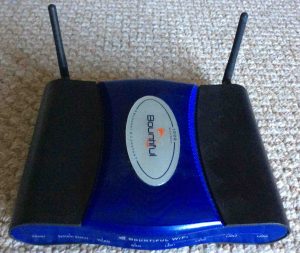
How to Fix WiFi Router Issues
We run a few routers in our computer lab often. Plus, we hear much of the scoop in our building about the router problems. Both novice and advanced network users face these. So, so often a failing router causes their woes. We list below some of these common router problems, along with how we and our neighbors solved them.
Router Does Not Power ON
Symptom of this problem is that all lights on it are dark. Plus, you can’t connect to it. In fact, its SSIDs do not appear when you scan for WiFi networks. In this section, find common causes and fixes for the router-has-no-power issue.
Check Power Cords
Plug the power cable / adapter in at both ends. You have the 120-volt outlet end. And, you have the the low-voltage jack that fits into the router’s DC power port.
Does Outlet Have Power
Check that the 120-volt outlet has power. To do that, use a plug tester light. Or plug a lamp into it and see that it comes on.
Fix Power Outlet
If not, restore power to the outlet by turning on any switches that may control it. Check that you have no blown fuses or tripped circuit breakers that feed it.
Test the Router’s Power Supply
But if the 120-volt outlet checks out okay, check the voltage output of the router’s power adapter. The output should be within 5% of the rated DC value. This value you’ll often find somewhere on the adapter case.
Swap Out the Power Supply
Or, if you happen to have a spare adapter in house, try swapping it for the suspected one. If the substitute powers on the router, then replace the adapter.
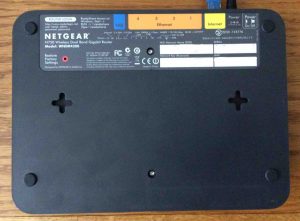
Router Working but No WiFi Signal
Turn On the Wireless Radio
The WiFi radio may be OFF. You can often control ths in the router’s settings menus. Often you find it on the advanced settings pages.
Check and turn the radio ON, if it is in fact OFF.
Replace Router
Or, the WiFi transmitter may have failed. So replace the router to verify.
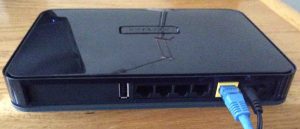
WiFi Login Failures
Check Password
Make sure you know the password that your WiFi router wants. If you don’t know it, then change the password to something that you will not forget.
Check Security Mode
You normally don’t have to do this these days. Why not? Because most client wireless devices can find the right security mode as they handshake with the router.
But you must know if the wireless connection uses WEP, WPA, or WPA2 to manually enter the wireless network info. You must do this when you connect to an hidden network. In that case, you must punch in its SSID, password, and security mode by hand.
Weak or Slow WiFi, Even When Close to Router
Set Radio Power Output to Maximum
Many routers feature a power output setting. So it’s possible that someone changed this. Or a recent router move needs more power to fully cover your space. Thus try setting the output level to Full or 100 percent.
Replace Router Power Adapter
Also, a weak power adapter can weaken the routers WiFi signal. So try substituting an equivalent new supply.
Upgrade to a Higher Power Router
Your router may offer too little signal output to adequately cover your desired coverage area. So, upgrade to a unit that has higher power. Look for one with a few hundred milliwatts. Or better yet, find a router with the full 1 watt legal power.
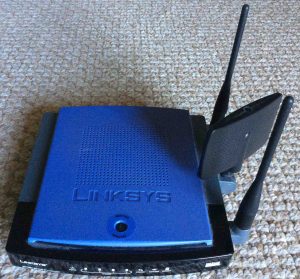
Unreliable WiFi Connections
While the local Ethernet ports work at top speed, the WiFi devices may slow down due to the following.
Busy WiFi Channel
Your wireless router is broadcasting on an overly crowded channel. So try switching the router’s channel number to fix. Why? Because many routers ship with their channel choice to occur at boot up. Indeed, the router does not always pick the best channel to use on its own.
Furthermore, channel traffic can change since the last boot.
Or the router picks a channel without enough pre-scanning to test just how busy it is. Run a WiFi checker app to check channel traffic yourself. We use the Amped Wireless WiFi Analytics app. This app shows the least busy WiFi channel in your area.
Once you know the best channel, then set your router to it.
Overly Crowded 2.4 Ghz. WiFi Frequencies
Now perhaps all the channels show strong WiFi activity in the WiFi Analytics app. Or you have many non WiFi devices in your home that run on 2.4 Ghz. If either case is true, then switch ON your router’s 5 Ghz. network. Or upgrade to a dual or tri band router that has it. Then move your devices over to the higher frequency network.
Or, you might add a 5 Ghz. wireless network without replacing your router. For this, add a 5 Ghz. wireless access point. Netgear offers such devices.
But beware that not all client devices support 5 Ghz. wireless N or AC.
Desired WiFi Coverage Area is Too Large
The size of your home, apartment, or industrial coverage area may simply be too big for a single WiFi router. Even a full power router may struggle to reach all places in your home. So, you could try adding more access points and WiFi range extenders. Put these at the most distant points from your ISP router, to fill in the dead spots.
Of course, this means either…
- Running new LAN network cables to the distant access points.
- Adding MoCA (media over coax) units. This is simple if you have coax cable for cable TV near to both the router and access point.
- Use Ethernet over power line adapters. These translate and send Ethernet data over the power lines in your home.
Similar tech exists to connect distant routers together over the power wiring. But whatever the connect method, your goal is to put WiFi access points into those “fringe” spaces.
Non Even Signal Coverage
Many WiFi routers and access points have antennas that you can swivel around.
Re orient WiFi Router Antennas
Try reorienting the antennas to see if signal coverage in your target areas improves. Also, some routers like the Asus Dual Band Router RT-AC87R that have beam forming tech. For this to work well, you must place the antennas according to a supplied sketch in the users guide. Orient the antennas as shown there.

Pick a Better Place to Put your WiFi Router
Or, try installing the router in a central spot. This assures more even signal spread throughout your home.
Upgrade to a MIMO WiFi Router
Multiple Input Multiple Output routers often have more than one antenna and radios. Where one antenna might not get the signal well, another one often will. That’s true even when they are very close to each other.
So the system switches between its antennas as signal conditions change. In this way, it chooses the best signal path at all times. MIMO often reduces dead spots and weak WiFi around home. Plus, this tech is part of the Wireless N standard. So you need at least an N router to enjoy it.
Router Stability Problems
If WiFi or wired data show changing speeds or slow transfer rates, then try the following.
Check All Connections
See that every Ethernet plug is tight and true.
Install Latest Firmware
Or, if the problem started AFTER you install the latest version, try installing an older but more stable firmware.
Check and Replace Power Supply
A bad adapter also causes frequent router crashes and restarts.
Tightly Fasten Any Antennas
Loose aerials can make the router less able to pick up WiFi signals from your phones and tablets. They can also shorten its range.
Move Router Far from Noise Sources
Adjust Antenna Positions
Check that All Cables can Handle Gigabit Data Speeds
Faulty Ethernet Cables
Replace all network cables with at least CAT-6 patch cords. Use shielded cords for best results.
Bad Power Supply
Replace the adapter.
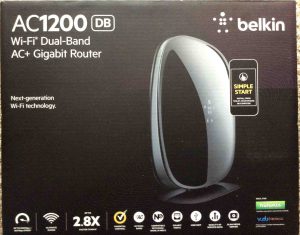
How to Fix WiFi Router: Conclusion
Hopefully, these answers help you fix any WiFi router troubles you have. As should be apparent now, you need not always replace your router to fix some issues.
But if you do choose to replace your router after all, see our How to Replace Old Defective Wireless WiFi Routers piece for help.
If you wonder jhow to know when to retire your router, then please see our Time to Replace Your Wireless Router When… piece. There, we give common symptoms and behaviors that mean that your best bet is to replace the router.
Related Posts to How to Fix WiFi Router
- How to Choose a Wireless Router
- Netgear N750 WNDR4300 Review for this Gigabit Router
- When to Replace WiFi Wireless Router
- Change WiFi on Logitech Squeezebox Boom Radio
- Linksys WRT300N Router Review, Wireless-N Broadband
Suggested Reading
- CBS Streaming Video Fails to Play in Internet Explorer, How to Fix
- How to Install HP DeskJet 3630 Series Wireless Printer
- Belkin F9K1106v1 Wireless Extender Review, N600
- Connect WiFi on Denon S 32 Internet Radio, How To
- Solving Honeywell WiFi Thermostat Connection Problems
References for How to Fix WiFi Router
- How to Fix Your Internet Connection at WikiHow.com
- How to Troubleshoot Wireless Router Problems at HowToGeek.com
Revision History
- 2020-04-19: Added tags.
- 2019-06-11: Added targeting for ‘How to Fix WiFi Router’, removed ad code, and added more tags and links.
- 2016-01-14: Added more appropriate tags.
- 2015-09-27: Added appropriate tags.
- 2015-07-20: Originally published.
